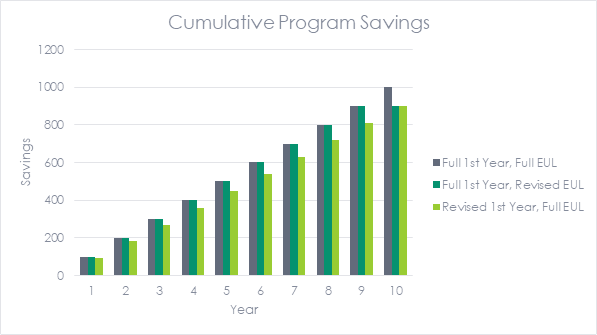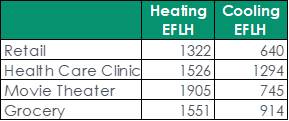How to Claim Savings from a Closed Business
Every now and then, we are asked to evaluate an energy efficiency project completed at a business that has since closed. This poses some tricky questions: how much savings should a program claim for these measures and how much savings will actually occur? As the industry shifts from focusing on first-year savings to lifetime savings, this issue becomes even more problematic.
If evaluators find that a business has closed during the program year or during the evaluation cycle, we have two general options when estimating savings for the project:
- Option 1: Assume full first-year savings for the project and account for business closures in the effective useful life (EUL) estimate to arrive at the correct overall lifetime savings for the program.
- Option 2: Adjust first-year savings to account for the closed business, either by assuming zero savings or prorating savings based on the amount of time the business was operating. The program’s lifetime savings would then be calculated by using an EUL that does not account for business closures.
If we do not dig too deep, it may seem like each of these options are equal. In a simplified example, if we assume that 10% of savings come from closed businesses (so that either first-year savings or the lifetime is reduced by 10%), then after the measure’s EUL of 10 years, the cumulative lifetime savings in both scenarios is the same.

However, we should dig deeper because both options have issues.
Option 1: Trust the EUL?
In the first scenario, programs would account for business closures in lifetime savings. However, claiming the full first-year savings and using the EUL to derive the correct lifetime savings assumes that the EUL estimate is 1) accurate and 2) incorporates business closures. As we have explored before, EUL values notoriously lack rigor and it is often not known what assumptions they include (e.g., are they based on the technical life or do they account for factors such as early retirement and business turnover?). To best use this approach, our industry needs to conduct much more rigorous persistence research with clearly defined assumptions in order to put faith in lifetime savings estimates. A second major drawback of this scenario is that first-year savings will be overstated because a full year of savings is being claimed despite only a partial year of operation. For programs that report savings on both a first-year and lifetime basis, you can’t have it both ways.
Taking it a step further, a rigorous EUL analysis will determine if the equipment is in place and operational (and if not, when it failed), but likely will not take into consideration how it is being operated. If a business closes, there is some percentage of chance that a new business will take its place. However, some types of businesses and equipment are more likely to result in persistent savings than others. For example, a strip mall grocery store that gets converted into general retail space will likely see its efficient refrigeration measures get removed. On the flip side, the rooftop AC unit will probably be able to be used for a variety of business types over its lifetime.
If we really care about accurate lifetime savings, though, we need to recognize that not every business will use the equipment the same and have the same level of savings. Let’s assume that a strip mall grocery store closed and was replaced by a different type of business. Although the rooftop unit may still result in savings for the program, the savings may be substantially different for a different business. See the table below for an example of the differences in effective full load hours of HVAC equipment for types of businesses that might replace a grocery store in a strip mall.
Effective Full Load Hours for Existing Buildings in Chicago
Source: IL TRM
Finally, even if the same business type replaced the first occupant with the exact same usage patterns and savings, there would likely be some amount of downtime while the space turned over to the new company. If we really care about accurately measuring savings, then we should account for this pause first-year savings and then not in future years.[1]
Option 2: Closed Businesses Don’t Advertise
The second option is to account for business closures in the first-year savings by assuming no savings for measures implemented by businesses that close in the first year or by prorating the savings based on the amount of time the measure was in use. In order to not double-penalize the program when estimating lifetime savings, we would need to ensure that the EUL does not account for business closures.[2] While this approach seems reasonable for first-year savings, it also is problematic.
First, as discussed last month, programs often claim savings for a full year of savings regardless of when in the year they are installed. Not claiming full first-year savings for measures that were installed would not be consistent with other projects and would create policy headaches.[3] Second, this approach only accounts for business closures identified in the first year or during the evaluation cycle. If a business closed in year 2, the measures would receive the full first-year savings for its full EUL, which would overstate savings. Third, this approach only works when we can identify business closures. In practice, evaluators may not identify closed businesses because they may be masked as non-respondents. If an email does not bounce back or the phone is not answered, we may never know the difference between someone screening their calls and an empty facility. Ultimately, this may mean that we are overstating program savings (slightly).
So What Do We Do?
Hopefully, it is clear that accurately accounting for business closures raises issues regardless of approach. My gut says that the first option is the better long-term choice because it requires the most attention to the persistence of measures and savings. As programs focus more on lifetime savings and the accumulation of carbon emissions, more research will need to be done to determine how much measures actually save over their lifetime.[4] However, I can also see the arguments for accounting for closures as the first-year savings because that is where the most evaluation resources will be devoted, leading to a more accurate answer. Regardless of which approach is used, there needs to be greater transparency of the assumptions being used to prevent double counting and, most importantly, to show where these assumptions can be improved with future research.
[1] Unless we applied some probability of future business turnover at that space.
[2] Which may be hard to tell.
[3] Please note that I am not advocating for the status quo because change is hard.
[4] And what that lifetime is.

%20(1).png)
